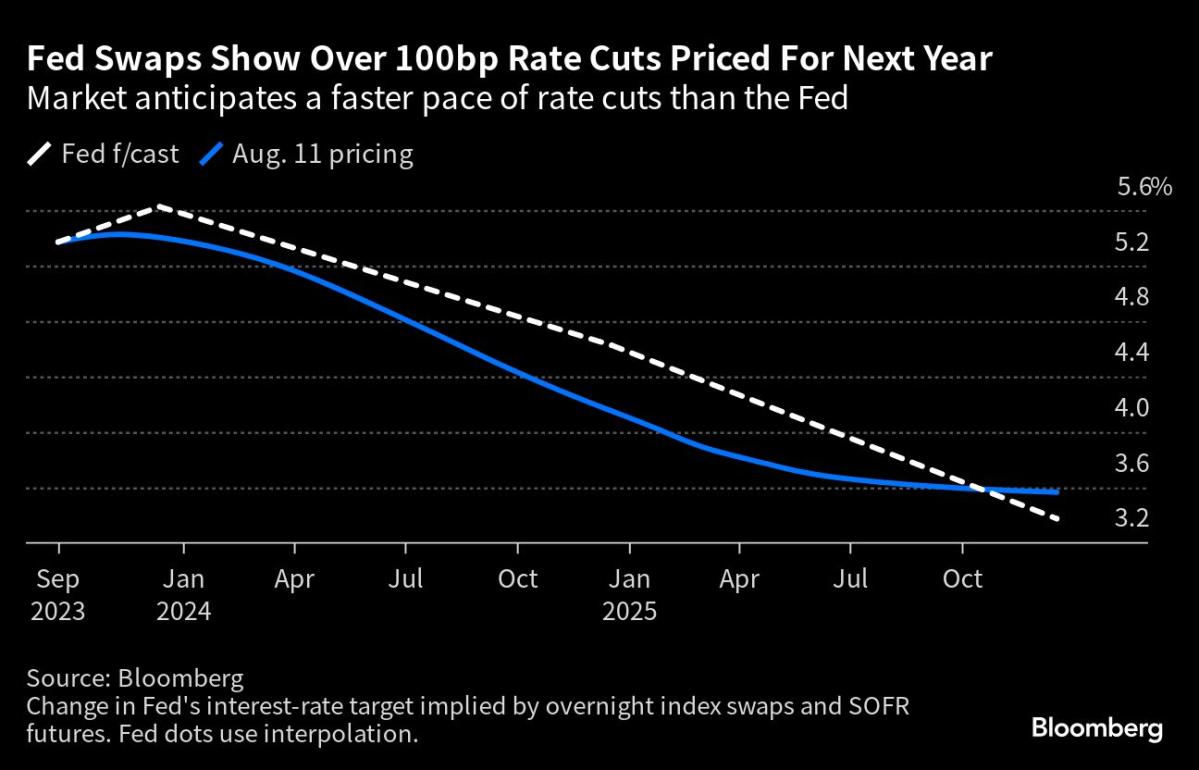(Bloomberg) — Across Wall Street, there is growing relief that the Federal Reserve — finally — may raise interest rates. But this does not mean that turmoil in the bond market will soon be a thing of the past.
Most Read from Bloomberg
Investors expect US Treasuries to continue to collapse on increased volatility as economic uncertainty threatens to change the course of the central bank or keep interest rates higher for much longer than traders currently expect.
Already, some Fed officials contend there may still be more work to be done as inflation continues to hold above its 2% target despite the most aggressive monetary policy tightening in four decades. At Barclays, strategists have advised clients to sell two-year Treasuries in the hope that interest rates will remain high next year, bucking broader speculation that the Fed will begin a series of rate cuts as soon as March. And benchmark 10-year returns – a baseline for the broader financial system – are falling towards last year’s highs.
“The rise in long-term yields has been driven by the hawkish message from the Fed,” said Rob Waldner, chief fixed income strategist at Invesco. “The central bank remains hawkish and that keeps uncertainty high.”
This uncertainty, along with an increase in new debt sales as the federal government grapples with a growing deficit, has weighed heavily on the bond market. Even with the sharp jump in interest rates, the overall Treasury market has returned just 0.1% this year, according to a Bloomberg Index, far from the big gains previously expected to emerge when the end of the Fed hike seemed in sight.
After the central bank’s policy meeting in July, when it raised the overnight rate by a quarter of a percentage point, Chairman Jerome Powell emphasized that his decision at the next meeting in September would hinge on data released over the next two months.
So far, headline reports have generally supported speculation that it will hold steady in September, with job growth slowing and signs of easing inflation. But the core CPI – which excludes volatile food and energy prices and is seen as a better measure of underlying inflation pressures – still rose at an annual rate of 4.7% in July. On Friday, the producer price index rose faster than expected, sending Treasury yields higher across maturities.
Next week, traders will look to the minutes of the July 25-26 FOMC meeting for clues as to where policy makers see prices heading and any divergent views they have.
The annual gathering of global central bankers later this month in Jackson Hole, Wyoming, will also be closely watched. It could give Powell a place to resist pricing markets in that the Fed will cut its key rate to around 4% by January 2025. It’s in the 5.25-5.5% range now.
“The committee is divided,” said Subhadra Rajappa, head of US interest rate strategy at Societe Generale. “Market pricing shows lack of conviction. Six cuts are priced in. These are not deep cuts. This is a long story. I can’t see strong trade here.”
What does Bloomberg Economics say…
“Minutes of the July 25-26 Federal Open Market Committee meeting, scheduled for August 16, will show that the majority of Fed officials have been encouraged by progress in reducing inflation, but are not yet convinced that the rate hike cycle is over.”
Anna Wong, chief US economist
— read her full report here
However, some investors have been flocking to the Treasury market, due to rising interest rates and concern that this year’s stock market rally is unsustainable. That puts US Treasury bonds on track for a record year of inflows, according to strategists at Bank of America Corp.
Bank of America says US Treasury bonds are on track for a record year of inflows
However, Kerrie Debbs, a certified financial planner with Main Street Financial Solutions, has warned clients that bonds are not a sure fire haven from risk and that the stock market’s push higher may not last.
“There is still a whole host of events that could disrupt these positive market returns, including persistent inflation, the perception of credit quality of US government debt, massive US budget deficits, global political instability, and more,” Debs said. 50 clients and manages approximately $70 million in total assets.
what do you want to watch
-
Economic calendar:
-
August 15th: Retail Sales. import/export prices; Manufacturing Empire Business Inventory NAHB Housing Market Index; TIC streams
-
August 16th: MBA Mortgage Applications. building permits; housing beginnings; industrial production; Minutes of the Federal Open Market Committee meeting
-
August 17: Unemployment Claims. Philadelphia Federal Reserve business forecasts; leading indicator
-
August 18: Bloomberg poll, USA, Aug
-
-
Federal Reserve calendar
-
Auction calendar:
-
August 14: Bills 13 and 26 weeks old
-
August 15th: 42-day cash management bills
-
August 16th: 17-week billings
-
August 17: Bills 4 and 8 weeks old
-
– With assistance from Edward Bolingbroke and Farah El Bahrawy.
Most Read from Bloomberg Businessweek
© 2023 Bloomberg LP
